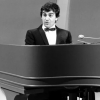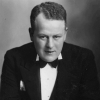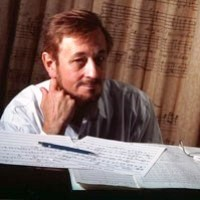Home » Jazz Musicians » Michael Garrick
Michael Garrick
Michael Garrick's adolescent love affair with jazz is a tale shared by much of middle class England in the post-war years, when national service was often the only means to have this affair requited. Swing and boogie-woogie held a "magnetic attraction, but I had no means of getting near it," he says; Pine Top Smith and Meade Lux Lewis (he will still rattle off Honky Tonk Train Blues if you let him), Lionel Hampton and Harry James, whose music "thrilled me to death," all crossed his path leaving indelible stains on his youthful psyche. He had fallen for the siren's song, did not know what jazz was, but knew that he wanted to play it. To this day he is rather proud of the fact that he was expelled from Eleanor B. Franklin-Pike's piano lessons for inflicting Glenn Miller's In the Mood upon fellow pupils at a musical soiree; but more seriously his parents disapproved of such high spirits and tried to put him off. In deference to this musical apartheid both at home and within the educational establishment, Garrick was adroit enough to sidestep the issue by not studying music at university, where musical faculties displayed the sign "bebop not spoken here." Yet his ambition to become a dance band pianist, or even better to play jazz, was undiminished, and to this end he practised his arpeggios, put himself through grade eight exams after national service, and embarked on a degree in English literature at University College, London.
While a student Garrick formed his first quartet, in part a carbon copy of the Modern Jazz Quartet, with the novice pianist aping the economy of John Lewis' lines and Peter Shade, "who luckily was a raver," providing the pyrotechnics on vibes. English folk song, Greensleeves, Barbara Allen and Bobby Shaftoe, plus Now's The Time and his own Wedding Hymn (which became part of Jazz Praises), were in the repertoire. Playing opposite Joe Harriott's group at the Marquee in 1958 and 1959 opened his eyes, and his own musical development through the 1960s saw the Walls of Jericho come tumbling down as Garrick raced from one project and one group to another: Poetry and Jazz recitals to his celebrated Jazz Praises, small ensemble compositions to large-scale oratorio projects infused with a jazz passion, and many recordings both as session leader and with the Don Rendell and Ian Carr Quintet.
Yet the foundations upon which Garrick has built his career have remained secure and have changed very little since the late-1950s and early-1960s, for at the heart of Garrick's playing is a wonderful and unique brand of 'Englishness', of democratic invention, boundless adventure and a sense of place. For sure Garrick had the awareness to take on board all that the American jazz heritage could offer, but he did more than just assimilate this culture. These sounds were distilled through his own personal experience, of course; but more importantly through his own cultural experience, and his brand of jazz has always been shaded by the pastoral greens and social mores of his English and urbane upbringing. The younger Garrick's partial ignorance of the jazz greats may have helped him here, for serious listening to the classic recordings of the past was a luxury that fell upon him slower than perhaps most: he did not become awake fully to Parker's gospel until after he had embarked on a professional career, and much of Ellington's oeuvre he did not discover until his late twenties - a source of retrospective relief, as Garrick feels that he may have wilted when faced with the challenge of Ellington's achievements at an earlier stage of his development.
Read moreTags
The Don Rendell / Ian Carr Quintet: Warm Up

by Chris May
British modern jazz was gaining new confidence in itself in 1965, when Warm Up, subtitled The Complete Live At The Highwayman 1965, was recorded. It needed to be. As Simon Spillett writes in his liner notes, at the time “British jazzmen bravely fought a battle on two fronts, one against the stranglehold of American influence, the other against the Beatles." British jazzwomen, of course, were fighting on three fronts; but we can discuss that another time. A fourth front, fought ...
Continue ReadingMichael Garrick: Black Marigolds and October Woman

by Andrey Henkin
Michael Garrick Black Marigolds Vocalion 2005 Michael Garrick October Woman Vocalion 2005 British musicians like pianist Michael Garrick inhabit the grey area between the energetic, if somewhat derivative realms of Johnny Dankworth and Tubby Hayes that preceded them and the much more advanced, if undervalued, contributions of the John Surman, Keith Tippett and Spontaneous ...
Continue ReadingMichael Garrick Sextet with Norma Winstone: The Heart is a Lotus
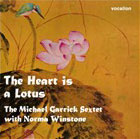
by John Kelman
With a resurgence of interest in what many call the “Golden Years of British jazz--the mid-'60s through early '70s--labels like Vocalion are helping to fill in the blanks on the period when a specifically British sound began asserting itself, in contrast to the America-centric music of prior decades. While the music of emergent artists like saxophonist John Surman and trumpeter Ian Carr exhibits clear stylistic precedents from across the pond, there's also something indefinably British there, too--perhaps a hint of ...
Continue ReadingMichael Garrick: Oct. Woman
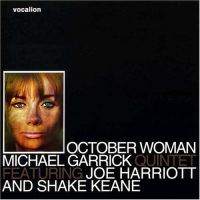
Source:
JazzWax by Marc Myers
Michael Garrick was an English jazz pianist who today is little known in the U.S. Born in 1933, Garrick was a self-taught musician who majored in English literature. Emerging from college in 1959 into a British world where mod jazz and poetry were trending, Garrick wound up the musical director of Poetry & Jazz in Concert, a touring ensemble of performance artists. From 1965 to 1969, Garrick led a contemporary jazz group that included saxophonist Don Rendell and trumpeter Ian ...
read more












